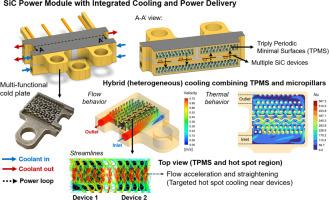Unlocking the Potential of Integrated Cooling and Power Delivery in Multi-chip Power Electronics Packages with Triply Periodic Minimal Surfaces (TPMS)
IF 5.8
2区 工程技术
Q1 ENGINEERING, MECHANICAL
International Journal of Heat and Mass Transfer
Pub Date : 2025-09-25
DOI:10.1016/j.ijheatmasstransfer.2025.127866
引用次数: 0
Abstract
As power density demands in power electronics escalate, integrated power delivery with embedded fluidic cooling has gained interest to leverage the exceptional characteristics of wide bandgap semiconductor devices. However, application-specific constraints—such as dielectric coolants, fewer package layers, and lack of top-sided access for fluid ports—significantly limit the potential of this technology, leading to excessive fluid heating and reduced cooling effectiveness. These challenges become even more pronounced with homogeneous heat transfer enhancement structures, which lack the ability to provide spatial control of flow patterns. To unlock the potential of integrated cooling and power delivery, we proposed a hybrid architecture combining triply periodic minimal surfaces (TPMS) with micropillars to target local hot spots and enhance flow mixing where most needed. The cold plates were additively fabricated using binder jetting technique, and computational models were experimentally validated to unveil underlying physics, examining the unique flow structures generated by the combination of TPMS and pillars under diagonal flow. The swirling motion through a network of high-curvature channels intensified local vorticity, leading to disrupted thermal boundary layers and enhanced convective heat transfer. Unlike conventional micropillar-based cooling, which suffers from a downstream decline in local Nusselt number (Nu), the hybrid design expands the effective heat removal area by sustaining a positive downstream Nu gradient in the hot spot region. Overall, the hybrid architecture achieves a 17.9–57.0% increase in the average Nu compared to the traditional solution, offering promising potential to meet increasing power density demands with reduced cooling power overhead.

释放三周期最小表面(TPMS)多芯片电力电子封装集成冷却和电力输送的潜力
随着电力电子设备对功率密度的需求不断升级,嵌入式流体冷却的集成功率传输已经引起了人们的兴趣,以利用宽带隙半导体器件的卓越特性。然而,电介质冷却剂、封装层数较少、流体端口缺乏顶部通道等应用限制极大地限制了该技术的潜力,导致流体过热和冷却效率降低。这些挑战在均匀传热增强结构中变得更加明显,这些结构缺乏流动模式的空间控制能力。为了释放集成冷却和电力输送的潜力,我们提出了一种混合架构,将三周期最小表面(TPMS)与微柱结合起来,针对局部热点,并在最需要的地方增强流动混合。冷板采用粘结剂喷射技术进行增材制造,并通过实验验证计算模型,揭示了其潜在的物理特性,研究了TPMS和柱在对角流动下结合产生的独特流动结构。通过高曲率通道网络的旋涡运动增强了局部涡度,导致热边界层的破坏和对流换热的增强。传统的基于微柱的冷却会受到下游局部努塞尔数(Nu)下降的影响,而混合设计通过在热点区域保持正的下游Nu梯度来扩大有效的散热面积。总体而言,与传统解决方案相比,混合架构的平均Nu提高了17.9-57.0%,在降低冷却功耗的同时满足不断增长的功率密度需求,具有很大的潜力。
本文章由计算机程序翻译,如有差异,请以英文原文为准。
求助全文
约1分钟内获得全文
求助全文
来源期刊
CiteScore
10.30
自引率
13.50%
发文量
1319
审稿时长
41 days
期刊介绍:
International Journal of Heat and Mass Transfer is the vehicle for the exchange of basic ideas in heat and mass transfer between research workers and engineers throughout the world. It focuses on both analytical and experimental research, with an emphasis on contributions which increase the basic understanding of transfer processes and their application to engineering problems.
Topics include:
-New methods of measuring and/or correlating transport-property data
-Energy engineering
-Environmental applications of heat and/or mass transfer

 求助内容:
求助内容: 应助结果提醒方式:
应助结果提醒方式:


